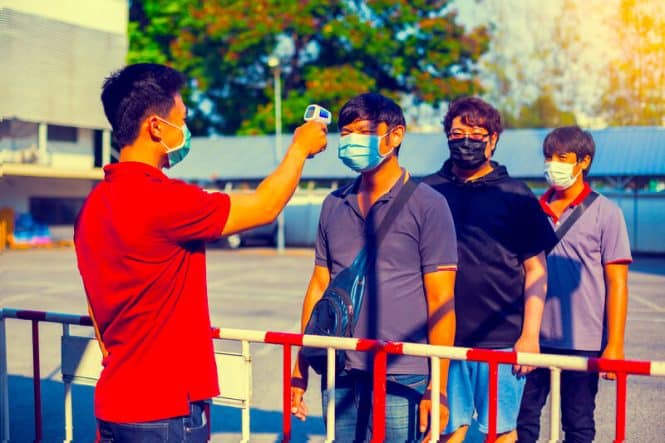

Table of Contents
Overview
There are several companies which are the component manufacturer of infrared thermopile sensors and infrared thermopile arrays. They simply provide the sensor component to manufacturers of devices. E.g. non-contact infrared thermometers like in-ear- and forehead thermometers (measuring from a small distance like 2-3cm) or devices for fever screening.
As the technology is basically the same (infrared thermopile), it is in generally possible to use IR array sensors for such kind of applications.
Accuracy and Reliability
The main question is about the accuracy of such systems and the reliability.
Many of the non-contact thermometer manufacturers claim to have FDA approvals for their devices and showing a “medical accuracy” of +-0.2°C. (this is true only if applied correctly).
Now with the upcoming of the new fever screening devices, that aim to measure from a greater distance, there is a need of a sensor with higher resolution, so instead of a “single pixel” like in ear and forehead thermometers, we see the smaller pixel thermopile arrays with different lenses to achieve a certain field of view that is best for their measurement setup. If you want to measure in a distance (like 50 cm), you will have to make sure that enough pixels of the array will be illuminated by the area of interest (e.g. human forehead). So the 33° FOV or 40° FOV are in general good options. (90° FOV is mostly used for person detection or hot spot detection, because it can overview a larger space. If you want to use this for forehead temperature measurements, you will have to come rather close to the sensor to illuminate enough pixels).
When selling factory calibrated thermopile array sensors to customers, several manufacturers state an accuracy of +-3°C or 3% (whichever is higher). This is due to the rather simple factory calibration and the high temperature range 0 to > 500°C the sensors can be used. Some manufacturers also offer an additional calibration for the temperature range of 30-45°C with a higher reproducibility of 0.3°C. Note here, that it is not called accuracy, but reproducibility, because manufacturers cannot guarantee absolute accuracy under any conditions. This is also why the FDA states you should control your ambient conditions.
So again, some manufacturers explicitly make the difference between absolute accuracy and reproducibility when selling sensors to customers. Manufacturers tend to give a rather big error range of +-3°C or 3%, because they will not guarantee for a better accuracy under any conditions. A higher accuracy can be achieved with additional calibration effort, in a limited temperature range and if you control your setup and environmental conditions (like also stated in the FDA guideline).
What also might be of interest for our readers is this paper about fever screening, previously published in 2009 after the swine flu epidemic. There it is shown that fever screening systems are just one tool to identify people with elevated body temperatures, but this will never be an exact measurement, so you will always have to retest with a “medical” thermometer. This paper talks also about the problem of the rate of “false positives” and “false negatives”, depending on the threshold you set on your system. E.g a low threshold will give you many “false positives” (systems judges a fever, even if they do not have one). Then you will have to re-test many people with the “medical” thermometer, but it is very unlikely that you will miss a person with a fever. If you set a higher threshold, you will increase the chance of getting “false negatives” (people with a fever will not be detected).
Thermopile Recommendation:
The KMA recommends multiple measurements and ideally independent lab testing of the specific sensors in the specific configuration, ideally with wide variety of subject including different racial profiles as many factors must be considered.
If we ask most manufacturers, they tend to say that these fever screening devices are only helpful to select people with higher temperatures and then their temperature should be taken again with a medical thermometer to verify.
- PDF – Fever screening and infrared thermal imaging: concerns and guidelines
- The problem of claiming accuracies of devices. The attached paper might be of interest because if you measure forehead temperature, you have to understand this is not body temperature (37°C), but well below depending on ambient conditions. Most devices will display temperature around 36° or 37°C, because that is the number most people have in mind when they talk about “normal” human temperature. Most devices will just add an offset to show 37°C instead of the real 35.2°C which is the measured forehead temperature value at room temperature. Article-skin-temperature-2016
Informational Video from one of the device manufacturers:
Standards Which Are Involved
These are standards which are involved. One way to verify quality is to ask potential manufacturers which standards (IEC or ISO or ASTM) are taken into considerations.
It is not unlike asking regarding HIPAA and ADA for that matter.
- IEC 80601-2-59 Ed. 2.0 b:2017
Medical electrical equipment – Part 2-59: Particular requirements for the basic safety and essential performance of screening thermographs for human febrile temperature screening - ISO/TR 13154:2017 (en)– Medical electrical equipment — Deployment, implementation and operational guidelines for identifying febrile humans using a screening thermograph
- ASTM – https://www.astm.org/Standards/E1965.htm Designation: E1965 − 98 (Reapproved 2016)
Standard Specification for Infrared Thermometers for Intermittent Determination of Patient Temperature 1
Another Point of View
Request More Information
[contact-form to=”[email protected]” subject=”Thermopile FAQ”][contact-field label=”Name” type=”name” required=”1″][contact-field label=”Email” type=”email” required=”1″][contact-field label=”Message” type=”textarea”][/contact-form]
More Links
Brochure PDFS
Devices
-
- Melexis Medical-Thermometer-Application-Flyer-Melexis
- Far Infrared Selection Chart Melexis models – Melexis FIR-Selection-Guide-Melexis
